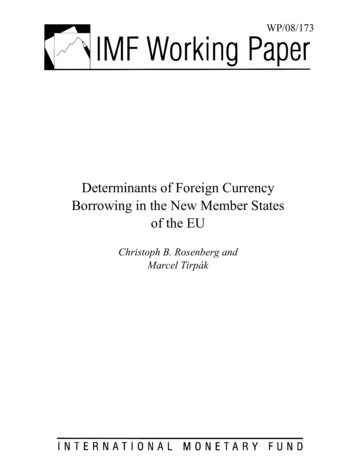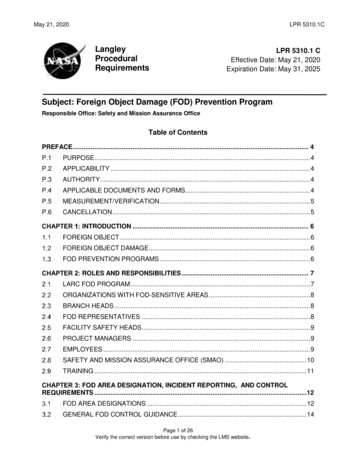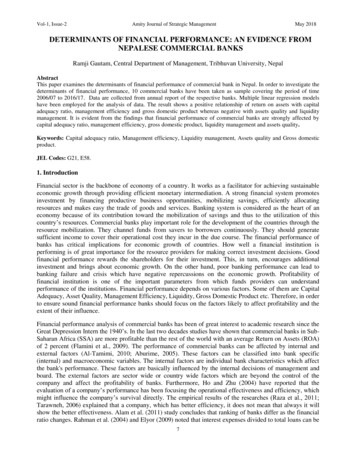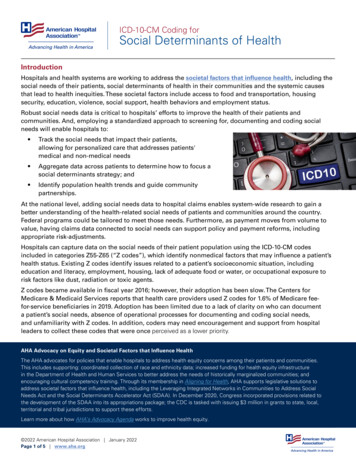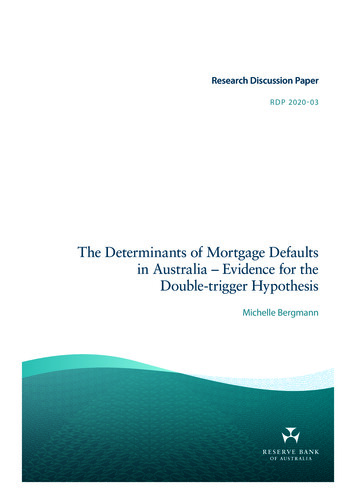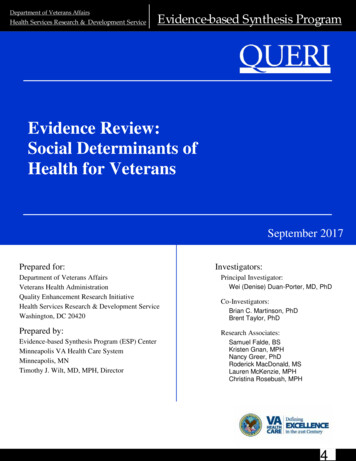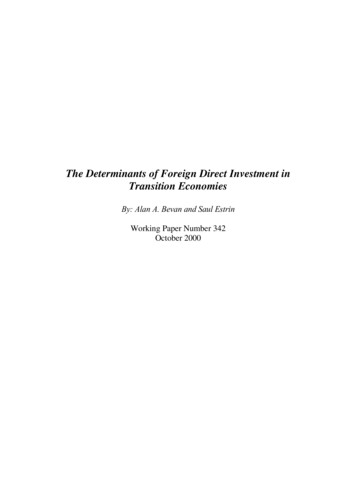
Transcription
The Determinants of Foreign Direct Investment inTransition EconomiesBy: Alan A. Bevan and Saul EstrinWorking Paper Number 342October 2000
William Davidson Institute Working Paper 342The Determinants of Foreign Direct Investmentin Transition EconomiesAlan A. Bevan and Saul EstrinCentre for New and Emerging Markets, London Business SchoolAbstractUsing a panel dataset containing information on FDI flows from market to transition economies, weestablish the determinants of FDI inflows to Central and Eastern Europe: country risk, unit labourcosts, host market size and gravity factors. In turn, we find country risk to be influenced by privatesector development, industrial development, the government balance, reserves and corruption. Byintroducing structural shift dummy variables for key announcements of progress in EU accession weshow that announcements have impacted directly upon FDI receipts but have not influenced countrycredit ratings. The Agenda 2000 announcement by the European Commission induced a bifurcationbetween the ‘first wave’ transition countries and the remainder of our sample. The underlyingdynamics of the process illustrate that increases in FDI improve country credit ratings with a lag,hence increasing future FDI receipts. Consequently we suggest that the accession progress has thepotential to induce virtuous cycles for the frontrunners but may have serious consequences for theaccession laggards.JEL Classification: F2, P27,C33Keywords: Foreign Direct Investment, EU accession, Transition EconomiesContact details:Centre for New and Emerging MarketsLondon Business SchoolSussex PlaceRegent’s ParkLondon NW1 4SAOCTOBER 2000Tel: 44 (0)20 7262 5050Fax: 44 (0)20 7724 8060E-mail (Bevan): abevan@london.edu(Estrin): sestrin@london.eduAcknowledgements: The authors are grateful to the Economic and Social Research Council for financial supportunder its One Europe or Several? Programme, Grant No.: L213 25 2003. We would also like to thank AlanSmith, Mario Nuti, Laza Kekic, Paul Geroski, Simon Commander, and participants of the 12th Annual Meetingof the Society for the Advancement of Socio-Economics, London School of Economics, 10 July 2000 andseminars at the Economist Intelligence Unit and Brunel University, for their helpful comments on earlier drafts.Any remaining errors are our own.2
William Davidson Institute Working Paper 342Non-Technical SummaryThe transition from socialism to capitalism in Central and Eastern Europe is both a politicaland economic process. One of the most important political aspects concerns the reintegrationof CEE into Europe, symbolised by many countries by prospective membership of theEuropean Union (EU). Economic integration, by contrast, is an extremely important aspect ofeconomic transformation. In this regard foreign direct investment plays a crucial role, interms of fostering accelerated growth, technical innovation and enterprise restructuring.Hence in this paper we offer a rigorous econometric model of the foreign direct investmentprocess in the CEE transition economies. In so doing, we examine the role played byeconomic and political risk in the host economy, and the influence of prospective EUmembership.Our analysis is based upon a new panel dataset containing information on FDI flows from 18established market economies to 11 transition economies over the period 1994 to 1998. Wedevelop an eclectic approach under which we establish that FDI inflows are determined bycountry risk, unit labour costs, host market size and gravity factors. We simultaneously modelthe credit rating of the host transition economy and find it to be strongly influenced by privatesector development, industrial development, the government balance, reserves andcorruption. By introducing variables for key announcements of progress in EU accession, weshow that announcements have impacted directly upon FDI receipts but have not influencedcountry credit ratings. Hence we find that political announcements concerning timetables foradmission to the EU can increase levels of FDI thereby improving economic performance.We find that the dynamics of this process indicate that it is likely to be self-reinforcing, asFDI receipts improve the country’s credit rating and hence further stimulate FDI inflows.In contrast, our findings suggest that countries excluded from the EU, typically because ofpoor progress in transition, will receive lower levels of FDI, which will further limit theirrelative transition progress. The implications are an increasing concentration of FDI into themore successful transition economies, and increasing differentiation in per capita incomewithin the region associated with inclusion or exclusion from the EU. Consequently wesuggest that the EU may wish to consider the policy implications of these identified processesas they suggest that the position of delayed entrants could deteriorate relative to thosecandidates earmarked for early entry, and the long-run consequences for delayed entrantsmay be grave.3
William Davidson Institute Working Paper 3421. IntroductionThe transition from socialism to capitalism in Central and Eastern Europe is both a politicaland an economic process (see e.g. Blanchard et al (1991); Portes (1993), Hare et al (1999)).An important aspect of the former is the possibility of reintegration into Europe symbolisedfor many countries by prospective membership of the European Union (EU) (see Grabbe andHughes (1998), Mayhew (1998)). Integration into the world economy, notably through tradeand capital flows, is a crucial and related element of the latter. Foreign direct investment(FDI) is a particularly important element of economic integration, because it openspossibilities for accelerated growth, technical innovation and enterprise restructuring, as wellas capital account relief (see Garibaldi et al (1999); Holland and Pain (1998)). EUmembership can be viewed as a determining element of the operating business environment,and this may directly influence the rate of FDI flows. In this paper, we offer a rigorouseconometric model of the foreign direct investment process into the transition economies,establishing the crucial role played by economic and political risk in the host country. Wealso explore the ways in which these factors have been mitigated by the prospects of EUmembership.Our work builds on two strands in the literature. The first is the analysis of the determinantsand impact of foreign direct investment in transition economies. This has drawn on the workof Lucas (1993) and Jun and Singh (1996) for developing economies, and has tended to focuson the business environment, trade integration, labour costs and the form of the privatisationprocess (see e.g. Lansbury et al (1996); Holland and Pain (1998); Brenton et al (1998);Garibaldi et al (1999); Resmini (2000)). Supplemented by surveys (see e.g. Lankes andVenebles (1996); Meyer (1998)), these studies indicate that, as in other developingeconomies, political and economic factors, the form and timing of the privatisation processand the need to secure market access have been the primary determinants of the allocation ofFDI across the region.FDI is also an important aspect of the transition process itself, and therefore of the businessenvironment for investing firms. There is growing evidence that enterprise productivity, R &D expenditure, innovation and company performance are higher in foreign owned firms —both in the transition economies and in the West (see e.g. Holland and Pain (1998); Barrelland Pain (1999)). This opens the possibility of virtuous and vicious circles in the transition4
William Davidson Institute Working Paper 342process, with one group of countries with positive initial conditions attracting high levels ofFDI, which further differentiates their business environment from their more risky transitionneighbours. This analysis is consistent with the raw data (see EBRD (1999)), which revealsthat FDI to the transition economies has been relatively high overall1 but has been veryconcentrated; around two thirds of investment to the region has been received by threecountries — Czech Republic, Hungary and Poland (see EBRD (1999)). Figure 1 belowillustrates that although the degree of concentration declined from 1991 until 1997 (with aslight increase in 1995) it remained extremely high even in 1998. Moreover, figure 1 revealsan interesting dynamic picture, whereby FDI receipts to the countries selected to form thefirst wave of EU accession (see table 4 below) appear to have ratcheted upwards from 1995.It is an important purpose of this paper to explore these dynamics more rigorously, and wetherefore return to this point in our empirical analysis.[INSERT FIGURE 1 HERE]A second strand of the literature covers the impact of supra-national trade agreements on FDI(see e.g. Baldwin (1994); Barrell and Pain (1999); Balasubramanyna, Salisu and Sapsford(1996)). Important examples which have been seen as being of relevance to the transitioneconomies include Mexico's involvement in the North American Free Trade Area, andSpain's membership of the European Union (see Martin and Velazquez (1997)). IndeedBaldwin, Francois and Portes (1997) have gone so far as to agree that the bulk of the gainfrom EU membership for transition economies will derive from increased investment, comingfrom both reduced domestic risk and increased FDI flows. This literature suggests thatprospective EU membership could be an important independent determinant of FDI intransition economies. We seek to investigate this issue below by exploring the impact ofannouncements about EU membership for the transition economies on FDI flows.Our approach is to build a rigorous econometric model of the foreign direct investmentprocess into the transition economies, using a new panel data set which allows us to identifyflows from individual donor to host economies. We have information on FDI flows from 181This finding is in contrast to the early literature e.g. Sinn and Weichenrieder (1997), which argued that FDIlevels to transition economies were low, relative to their income per capita. However, stocks have been growingrapidly, especially since the mid-1990s and in several countries such as Hungary, Czech Republic and Estonianow represent appreciable shares of investment and GDP (see EBRD (1999); Bevan and Estrin (2000)).5
William Davidson Institute Working Paper 342market economies to 11 transition economies, 1994-982. We develop an eclectic empiricalframework, in which FDI is determined by expected profitability, with the latter influencedby demand and cost factors, transaction costs and an evaluation of country risk given by thehost country credit rating. We simultaneously seek to model the credit rating in terms of avariety of macro-economic, transition and environmental factors. The model performs verywell and we find FDI to be strongly influenced by risk, labour costs, host market size andgravity factors. A host country's credit rating is determined largely by the private sectorshare, industrial development, the government balance, reserves and corruption.Announcements concerning EU membership are found not to influence a country's creditrating, but to affect FDI directly.Thus political announcements about timetables foradmission to the European Union can increase levels of FDI, thereby improving nationaleconomic performance. We find that this process has the potential to be self-reinforcing bylater improving the country’s credit rating and thus further stimulating foreign investmentflows. In contrast, countries excluded from the EU, typically because of poor progress intransition (see Grabbe and Hughes (1998)) will receive lower levels of FDI because theircountry credit ratings will be poor. This will further limit their progress in transition relativeto their more successful neighbours. The implications are an increasing concentration of FDIinto the more successful transition economies, and increasing differentiation in per capitaincome within the regions, associated with inclusion into or exclusion from EU membership.The EU may wish to consider the policy implications of these processes.The remainder of the paper is organised as follows. In the following section, we outline ourconceptual framework and summarise the theory on the determinants of foreign directinvestment. Our data are discussed in detail in the third section, which also presents the panelregressions for the FDI and risk equations. The section considers the mechanism by whichannouncement of progress in EU accession influences FDI receipts and perceived countryrisk ratings. The relationship between accession progress, FDI receipts and credit ratings,and the potential for vicious or virtuous circles, are explored in the conclusions.2There is some data for earlier years but the FDI levels are for the most part low and patterns are distorted bysingle lumpy projects between countries.6
William Davidson Institute Working Paper 3422. Conceptual FrameworkThough there has been considerable theoretical work on foreign direct investment (see e.g.Hymer (1960); Caves (1982); Buckley and Casson (1976)), there is no agreed modelproviding the basis for empirical work. Rather, Dunning's (1974, 1980) OLI paradigm hasprovided a taxonomic framework for most estimating equations. Dunning proposes that FDIcan be explained by three categories of factors; ownership advantages (O) for firms to operateoversees, such as intangible assets; locational advantages to investment in the host rather thanthe donor country (L), and the benefits of internalisation (I). The work on FDI into transitioneconomies has focused primarily on locational advantages of the region (see e.g. Resmini(2000)).Our estimating framework takes account of the fact that our data concern bilateral flowsbetween individual market and transition economies, denoted i and j respectively. FollowingCaves (1982), one can assume that firms will invest abroad when the expected return exceedsthe costs. One therefore needs to itemise the main factors in the donor and host countriesdetermining expected net profitability from investment.2.1.Factors Influencing Expected Profitability in Host EconomiesThe literature indicates that the key locational factors determining FDI are host countrymarket size, input costs — notably of natural resources and labour — and the riskiness ofinvestment, both in terms of the economic and the political environment (see e.g. Singh andJun (1995); Culem (1988)). Market size, typically measured by host country gross domesticproduct (GDP) captures potential economies of large scale production. In the transitioncontext, survey evidence suggests most firms invested in search of new market opportunities(Lankes and Venables (1996)), which can also be related to absolute market size.Expected profitability will also be higher in host economies if inputs costs, most notablylabour, energy and raw materials costs, are lower than in the donor economy. For most of thetransition economies, the key resource is labour, which is regarded as having relatively highlevels of skills and training (in comparison for example to regions with comparable per capitaincome levels in South East Asia or Latin America) and a strong scientific base (see EBRD(1999)). This indicates the inclusion of labour costs. However, firms only prefer low wage7
William Davidson Institute Working Paper 342locations if the reduced labour cost is not compensated by lower labour productivity, or anovervalued currency. Hence the appropriate measure is unit labour costs denominated in aforeign currency.Studies of FDI in emerging markets have put particular stress on indicators of economic andpolitical risk (see Lucas (1993); Jun and Singh (1996)). This comprises three main elements:macro-economic stability, e.g. growth, inflation, exchange rate risk; institutional stabilitysuch as policies towards FDI, tax regimes, the transparency of legal regulations and the scaleof corruption; and political stability, ranging from indicators of political freedom to measuresof surveillance and revolutions. In the transition context, this has been proxied in a variety ofways. For example, Holland and Pain (1998) follow Wheeler and Mody (1992) in using aprincipal components analysis across macro-economic and institutional variables, Garibaldiet al (1999) use a variety of World Bank and EBRD indicators and Resmini et al (2000) use asynthetic indicator of risk (the ‘operation risk index’). We favour an approach in which thecountry risk is proxied by information actually available to firms at the time of the investmentdecision — the credit rating — which can be purchased commercially.It is also widely argued that FDI and openness of the economy will be positively related (seeCaves (1996); Singh and Jun (1995)). This in part proxies the liberality of the trade regime inthe host country, and in part the higher propensity for multinational firms to export. Thereare measurement issues in transition economies however. The trade orientation pre-reformwas highly skewed towards the former Soviet Union, but did not necessarily reflectcomparative advantage (see Portes et al (1993)). Hence empirical work on the region hastended to use information about trade with Western economies, or with the major Westerntrading partner, the EU.In our work, we look at openness in terms of imports sourced from the EU-15. The EUoperates a trade regime designed to afford some protection to EU incumbents from third partyimport competition, by application of a common external tariff and through product licensing.The latter has been particularly important for the transition economies, and hence applicant’sexport trade with the EU reflects not only domestic trade policy, but also that of the EU.Moreover, in assessing applicants’ preparedness for accession the EU has considered suchfactors as product licensing, hence inducing a potential collinearity between EU export tradeand our announcement variables. This explains our use of import rather than export shares.8
William Davidson Institute Working Paper 342An important aspect of trade linkages is involvement or potential involvement in free tradeagreements, customs union and supra-national economic structures, such as the EuropeanUnion. Third party countries may invest into such regions to avoid tariffs on exports, whilethe enhanced growth and trade from the economies of scale of integration provide a demandstimulant to FDI. Within the EU context, accession for the transition economies would entailmembership of the Single European Market, and hence provide EU firms with theopportunity to relocate production in areas of lower labour cost. Moreover the prospect ofEU membership might be viewed by potential investors as reducing country risk; bothbecause to meet the requirements for EU admission represents an external validation ofprogress in transition, and because ultimate EU membership implies guarantees in terms ofmacro-economic stability3, institutional and legal environment4 and political stability. In oureconometric work, we therefore analyse the direct impact of a variety of agreements andannouncements between the EU and individual transition economies on FDI itself, as well asthe indirect impact via country-specific risk.2.2.Factors Influencing Expected Profitability in Donor and Host EconomiesAn important feature of our methodology is that it is based on bilateral FDI flows, and thusenables us also to consider donor country characteristics and the differences between donorand host economies.Commencing with donor country characteristics, large domesticmarkets may encourage firms with significant economies of scale to concentrate productionin a single plant, and export to other countries. However, economies of scale and scope inlogistics could also allow firms to run multiplant operations, and therefore locate productionclose to markets. Hence it is unclear whether the size of the donor economy GDP will bepositively or negatively related to FDI. The OLI framework suggests that, as trade becomesconcentrated in goods produced by firms using knowledge-intensive aspects, FDI willgradually replace exports. According to Grossman and Helpman (1991), small developedcountries which are particularly R & D intensive, such as Sweden and Switzerland, are morelikely to invest abroad, which suggests an inverse relationship between FDI and donor GDP.3For example, eradicating exchange rate risk via membership of the European Monetary System.EU membership involves the enactment into law of EU legislation across the range of commercial and civillaw, including trade rates, financial regulation and competition policy (see Mayhew (1998)).49
William Davidson Institute Working Paper 342Brainard (1997) developed a model which integrated the enterprise based approach of OLI togeneral equilibrium trade models.Multinational enterprises’ choices in serving foreignmarkets are determined by the trade-off between incremental fixed costs of investing and thecosts of exporting. While many of these costs are determined by the factors discussed above— economies of scale, relative input costs, intangible assets — the success of the gravitymodel in explaining bilateral trade flows points strongly to the inclusion of distance variablesin FDI equations. In these models, distance is used as a proxy for the transactions costs ofundertaking activities, which are assumed to increase (in a non-linear way) as the activitiesbecome based further away. For example, the costs of transport and communication rise, asdo the impact of cultural and language differences, the costs of using personnel placedabroad, and the informational costs of local property rights, regulations and tax systems, asfirms operate in regions which they do not know. It can be assumed that this unfamiliarity isbroadly a positive function of distance from home.However, for the transition economies, there are potentially three important provisos to thisargument. The first concerns Germany, which has traditionally had close ties of culture,language and tradition, as well as extremely tight economic integration, with the countries ofCentral and Eastern Europe. While some of these ties were disrupted during the Soviet era,even then the region remained closely integrated with East Germany.Transition andreunification of Germany has seen a strong re-emergence of these relationships. Hence, allother things being equal, one would expect lower transactions costs for German firmsoperating in the transition economies; a phenomenon for which we test in the empirical workwhich follows.Simple distance measures are also a poor indication of the transactions costs of doingbusiness in the Baltic states. The Baltic states have a dichotomous character owing to the factthat while they are small states that were part of the Soviet Union from 1939-91, theirtraditions, languages and institutions are linked to the Baltic basin, primarily Scandinavia.Thus, though they are geographically distant from most potential investors, they arepsychologically much closer, and this greatly reduces the cost of undertaking operations. Forthis reason, we also account for the Baltic states as a group in our regressions. Moreover,though many of the macro-economic indicators are poor because of their previous integrationinto the Soviet Union, their underlying economic potential is arguably better than implied by10
William Davidson Institute Working Paper 342their formal country rating. We therefore interact the Baltic dummy with the risk variable totest for this phenomenon.Finally, the United States is by far the largest foreign direct investor in the world, with ashare of global direct investment stocks in 1998 of 24 percent (United Nations (1999)).There are a number of possible reasons for this: the exploitation of scale and scopeeconomies, including the transport costs; the preponderance of firms specialising inknowledge based assets; and the learning effects from the large scale of overseas operationsreducing transactions costs of foreign investment. This suggests that, other things beingequal, US firms may invest relatively more than would be indicated by a simple gravitymodel, and we test for this our empirical work.Finally, there may be financial and capital constraints on foreign direct investment. As arudimentary attempt to control for these capital supply factors, we include an indicator of therelative opportunity cost of capital in the donor and host country, based on long run interestrates in each pair of economies.2.3.The Determinants of Country Specific RiskWe use the credit rating of the host country to measure the investor’s perception of countryspecific risk. These ratings give weight to economic, political and institutional performance,and hence we do not include any other indicators of macro-economic stability or prospects inour equations. However, in order to identify the independent effects of EU announcementson risk, we estimate a risk equation which includes proxies for macro-economic performance,progress in transition and corruption. After some experimentation, the included variables formacro-economic stability are the inflation rate, the government balance, the external debtstock and the end of year reserves. Crucial transition variables include the extent and methodof privatisation and the industrial sector share, while corruption is proxied by estimates of theextent of bribery required to undertake business in each country.11
William Davidson Institute Working Paper 3423. Empirical EstimationIn this section we firstly detail the nature of the compiled dataset and explain themethodological approach adopted. Sub-section 3.2 presents the results of our basicestimations to explain the determinants of FDI and country risk. In sub-section 3.3 we extendthese specifications to incorporate indicators of progress in EU accession. We also extend theanalysis to consider whether there exists a dynamic feedback relationship between FDIreceipts and country credit ratings.3.1. Data and MethodologyIn order to assess the determinants of foreign direct investment flows and country risk, wehave assembled a large panel dataset covering the period 1994 to 1998 inclusive. Eachobservation point in our dataset constitutes a relation between source country i (EU-14, asBelgium and Luxembourg are merged, Korea, Japan, Switzerland and the USA) and recipientcountry j (Bulgaria, Czech Republic, Estonia, Hungary, Latvia, Lithuania, Poland, Romania,Slovak Republic, Slovenia and Ukraine). Hence each observation details the flow of FDIfrom i to j — e.g. from Austria to the Czech Republic — in DM th. Our choice of sourcecountries reflects the fact that they are the major source of world FDI flows: their combinedFDI outflows in 1998 accounting for 87 percent of total world FDI outflows (United Nations(1999)); consequently residual FDI, and particularly that to the region under consideration, ismainly noise. Similarly, our choice of host countries was governed by the fact that their totalreceipts constituted 82 percent of total FDI received by the region in 1998 (United Nations(1999)). Moreover, given the focus of the current study, countries were also chosen on thebasis of their inclusion in the accession process, or in the case of Ukraine, being used as acontrol. We deliberately exclude Russia, the former Yugoslavia and other satellite states ofthe Former Soviet Union, as their conditions render them special cases which requirecountry-specific explanations5. FDI data is derived from various issues of the InternationalDirect Investment Statistics Yearbook published by the OECD, supplemented with data fromthe US Chamber of Commerce and Central Banks and Central Statistical Offices in the BalticStates in order to obtain the required level of disaggregation for the Baltics.5See Bevan, Estrin and Meyer (2000) for an example of the way in which the peculiarities of the Russian caseimpact on explanations of FDI receipts. In addition as Laza Kekic pointed out, FDI to Russia, as for Kazakhstan12
William Davidson Institute Working Paper 342Our empirical analysis has two-stages. In the first we analyse the determinants of foreigndirect investment flows from source country i to recipient transition economy j, estimating anequation of the form:(FDIij f DGPCi , HGPC j , DBERij , EUSMPj , RISK j , DISTij , ULC j , GER,USA, BALTIC)(1)where:DGPCi and HGPCj represent respectively the Gross Domestic Product of source country iand host country j in DM th. and are derived from International Financial Statistics Yearbook(IMF (1999));DBERij represents the differential between the end-year bond yield rate in source country iand the end-year deposit rate in host country j, both of which are also derived from theInternational Financial Statistics Yearbook (IMF (1999));EUSMPj represents the percentage of total imports of host country j from the EU-15, and wascalculated from data in the Direction of Trade Statistics Yearbook (IMF (1998)) for theperiod 1994 to 1997 and from the Direction of Trade Statistics Quarterly (IMF (1999)) for1998;RISKj represents the credit rating of host country j derived from various issues of InstitutionalInvestor magazine. Institutional Investor publishes their country credit ratings bi-annually inMarch and September on a scale of 0 (the lowest possible rating) to 100 (maximumcreditworthiness). We average the bi-annual scores to produce our annualised data;DISTANCEij represents the distance between capital cities of source country i and recipientcountry j in kilometres;ULCj represents the unit labour cost in manufacturing in recipient country j in DM6.and Azerbaijan, is likely to be significantly influenced by the substantial natural resource base of the economy,and hence would require additional country-specific explanatory variables to account for this.6In the absence
William Davidson Institute Working Paper 342 2 The Determinants of Foreign Direct Investment in Transition Economies Alan A. Bevan and Saul Estrin Centre for New and Emerging Markets, London Business School Abstract Using a panel dataset containing information on FDI flows from market to transition economies, we



